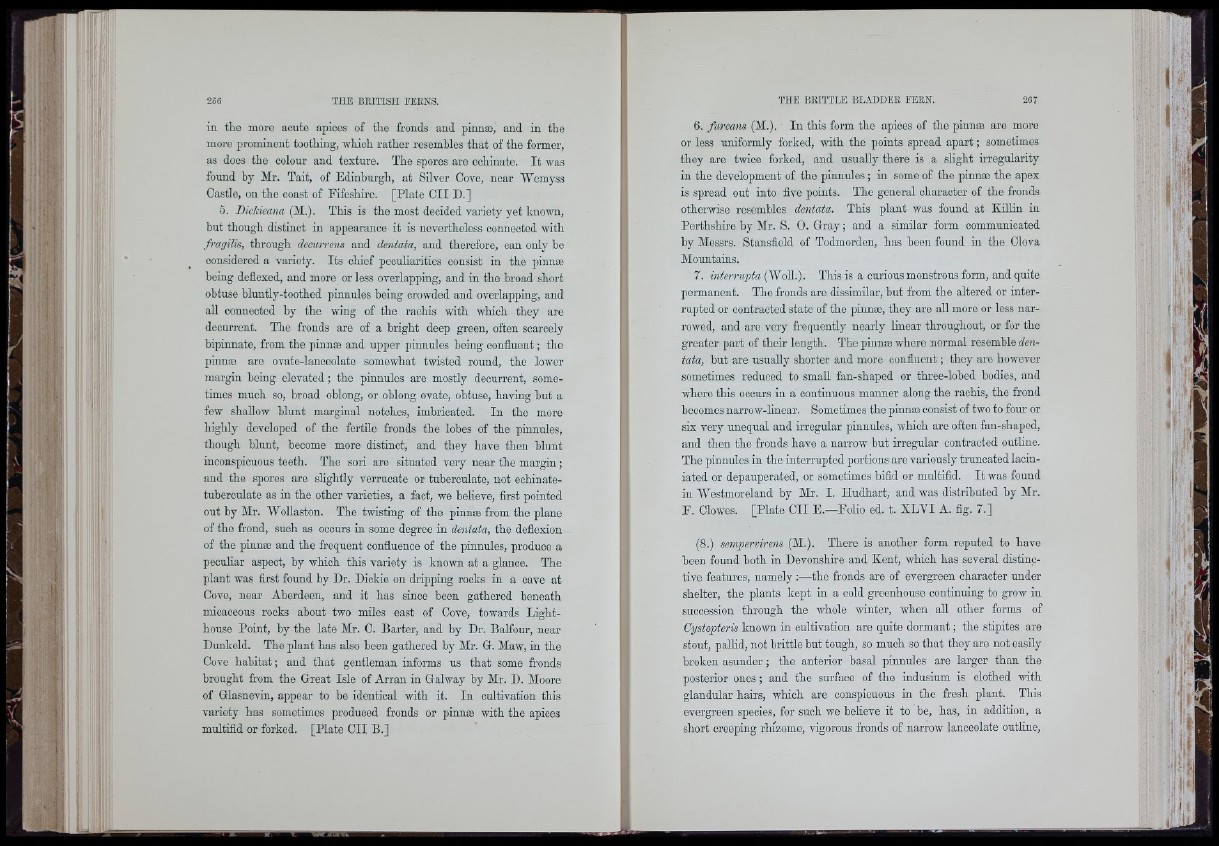
in tlie more acute apices of the fronds and pinnae, and in the
more prominent toothing, which rather resembles that of the former,
as does the colour and texture. The spores are echinate. It was
found by Mr. Tait, of Edinburgh, at Silver Cove, near Womyss
Castle, on the coast of Fifeshire. [Plate CII D.]
6. Bicldeana (M.). This is the most decided variety yet known,
but though distinct in appearance it is nevertheless oonneoted with
fragilis, through decurrens and dentata, and therefore, can only be
considered a variety. Its chief peculiarities consist in the pinnæ
being deflexed, and more or less overlapping, and in the broad short
obtuse bluntly-toothed pinnules being crowded and overlapping, and
aU connected by the wing of the raohis with which they are
decurrent. The fronds are of a bright deep green, often scarcely
bipinnate, from the pinnæ and upper pinnules being confluent ; the
pinnæ are ovate-lanoeolate somewhat twisted round, the lower
margin being elevated ; the pinnules are mostly decurrent, sometimes
much so, broad oblong, or oblong ovate, obtuse, having but a
few shaUow blunt marginal notches, imbricated. In tho more
highly developed of the fertile fronds the lobes of the pinnules,
though blunt, become more distmot, and they have then hlunt
inconspicuous teeth. The sori are situated very near the margin ;
and the spores are slightly verruoate or tuberoulate, not eohinate-
tuberculate as in the other varieties, a fact, we believe, first pointed
out by Mr. Wollaston. The twisting of the pinnæ from the plane
of the frond, such as occurs in some degree in dentata, the deflexion
of the pinnæ and the frequent confluence of the pinnules, produce a
peculiar aspect, by which this variety is known at a glance. The
plant was first found by Dr. Dickie on dripping rooks in a cave at
Cove, near Aberdeen, and it has since been gathered beneath
micaceous rooks about two miles east of Cove, towards Lighthouse
Point, by the late Mr. C. Barter, and by Dr. Balfour, near
Dunkeld. The plant has also been gathered by Mr. G. Maw, in the
Cove habitat; and that gentleman informs us that some fronds
brought from the Great Isle of Arran in Galway by Mr. D. Moore
of Glasnevin, appear to he identical with it. In cultivation this
variety has sometimes produced fronds or pinnæ with the apices
multifid or forked. [Plate CII B.]
6. furcans (M.). In this form the apices of the pinnæ are more
or less uniformly forked, with the points spread apart ; sometimes
they are twice forked, and usually there is a slight irregularity
in the development of the pinnules ; in some of tho pinnæ the apex
is spread out into five points. The general character of the fronds
otherwise resembles dentata. This plant was found at Eallin in
Perthshire by Mr. S. 0 . Gray ; and a similar form communicated
hy Messrs. Stansfield of Todmorden, has been found in the Clova
Mountains.
7. interrupta (Woll.). This is a curious monstrous form, and quite
permanent. The fronds are dissimilar, hut from the altered or interrupted
or contracted state of the pinnæ, they are all more or less narrowed,
and are very frequently nearly linear throughout, or for the
greater part of their length. Tho pinnæ where normal resemble dentata,
but are usually shorter and more confluent ; they are however
sometimes reduced to small fan-shaped or three-lohed bodies, and
where this occurs in a continuous manner along the rachis, the frond
becomes narrow-linear. Sometimes the pinnæ consist of two to four or
six very unequal aud irregular pinnules, which are often fan-shaped,
and then the fronds have a narrow hut irregular contracted outline.
The pinnules in the interrupted portions are variously truncated laoiniated
or depauperated, or sometimes bifid or multifid. It was found
in Westmoreland hy Mr. I. Iludhart, and was distributed by Mr.
E. Olowes. [Plate CII E.—Folio ed. t. XLAI A. fig. 7.]
(8.) sempervirens (M.). There is another form reputed to have
been found both in Devonshire and Kent, which has several distinctive
features, namely ;—the fronds are of evergreen character under
shelter, the plants kept in a cold greenhouse continuing to grow in
succession through the whole winter, when aU other forms of
Cystopteris known in cultivation are quite dormant ; the stipites are
stout, paUid, not brittle hut tough, so much so that they are not easily
broken asunder ; the anterior basal pinnules are larger than the
posterior ones ; and the surface of the indusium is clothed with
glandular hairs, which are conspicuous in the fresh plant. This
evergreen species, for such we believe it to he, has, in addition, a
short creeping rhizome, vigorous fronds of narrow lanceolate outhne.
1 1
m
i
i l
p
¥
' A